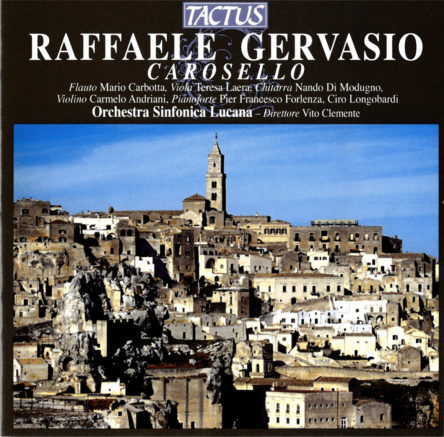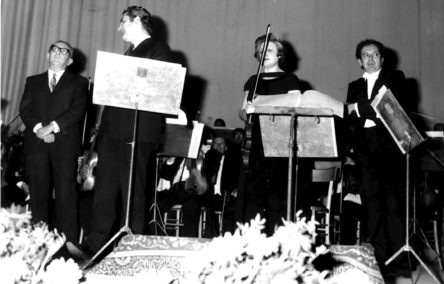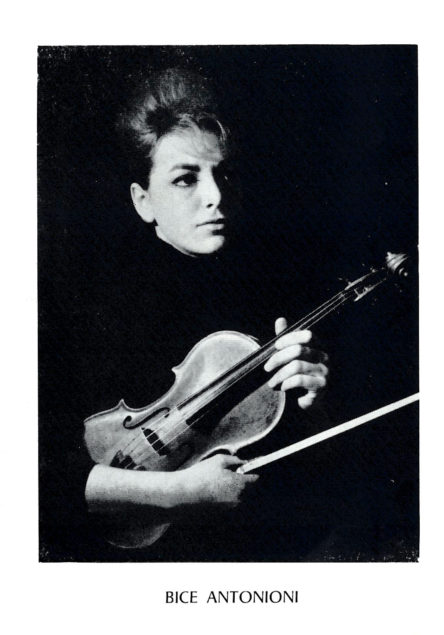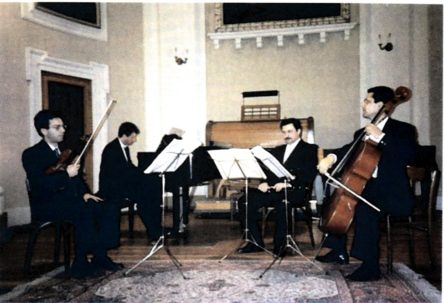The Sixties. Triptych for Violin
DOSSIER
Gervasio’s inclination towards serial works, typical of his production during this period, characterizes three important pieces in particular that were composed in the 1960s. They are Preludio e allegro concertantefor strings, piano and percussion, written in 1962, winner of the 1967 Ballo Award; Concerto per violino e orchestrawritten in 1966, winner of the 1968 Giordano Prize, and Composizione in lafor violin and piano, written in 1968.
Il Preludio e allegro concertante in a piece of celebrated success that has been performed numerous times (under the direction of Pierluigi Urbini, Mario Caracciolo, Mario Rossi, and more recently by Vito Clemente). Moreover, upon Vincenzo De Filpo’s request it was also reworked in 1992 for the Messiaen quartet in Riscrittura. On the occasion of a performance, Gervasio himself recalls: «In reviewing the Preludio e allegro concertante positively, the critics dwelt particularly on the ‘sound’ quality of the work [...]; I had great pleasure in this above all because I know that, while writing the piece, I didn’t look for ‘colors’ at all, but coexistences (yes, as is also my habit, going to great lengths) between seriality, alternating systems, that is octophonic, polyharmonic, and, why not ?, tonality. The phonic result of which, together with the rarely imitative and predominantly polylinear counterpoint, can obviously also be that of an unusual ‘color’.»
Il Concerto per violino e orchestra is one of Gervasio’s most important works which not surprisingly has as its protagonist his “favorite” instrument, the violin. In a concert program of one of its performances (with director Pierluigi Urbini and violinist Pina Carmirelli) it was said: «The main feature of this work is the revival of the idea of ‘concerto’. That is to say of something that leans on an effusive extroversion, on an ‘offering’ that is elaborated by the composer during composition, which can remain veiled. It is both support and justification of what the orchestra and, above all, the solo instrument propose to the listener. […] The concert presents, for its entire duration, the varied attitude of a twelve-tone series. [...] The various functions assumed by this series in the course of the entire work (as a statement, as accompaniment, even as harmonics bass) constitute an element that has a principle acoustic function [...] This acoustic function also unfolds with great variety for the entire duration of the score while respecting the traditional forms: playing with static points, with chromatic contrasts that are now violent, now meandering, and with ample vent to a typically Mediterranean cantability.»
Regarding Composizione in la, written for Bice Antonioni, who performed it countless times, Gervasio affirms: “If I hadn’t met Bice Antonioni, I probably would not have written Composizione in la. Only by way of the discovery of a thoroughbred violinist like her, someone who immediately appeared to me as a concert performer born as much in the virtuosic flicker as in the firmness and solemnity of an interpretative commitment; only from this (with the pride, moreover, of knowing that she is from my same region) could I be induced to fulfill a long-standing aspiration of mine. That is, the inspiration to write a purely ‘violin’ piece, a ‘morceau de concert’, as they used to say, in which the ‘king of instruments’ is entrusted with all the responsibilities that in a ten-minute composition is connected to the expressive line, the dynamic ‘consecutio’, and the structural squaring.»
In the cover photo, Pierluigi Urbini and Pina Carmirelli during the first performance of the Concerto per violino e orchestra (31 March 1970, Teatro Umberto Giordano, Bari Symphony Orchestra, Foggia, Italy)



